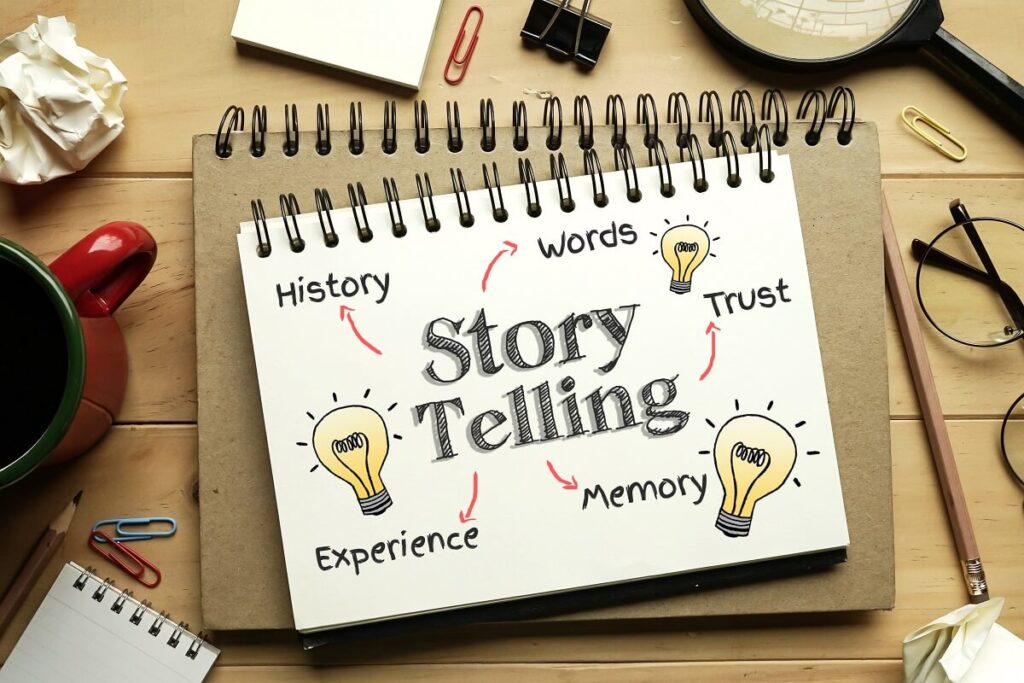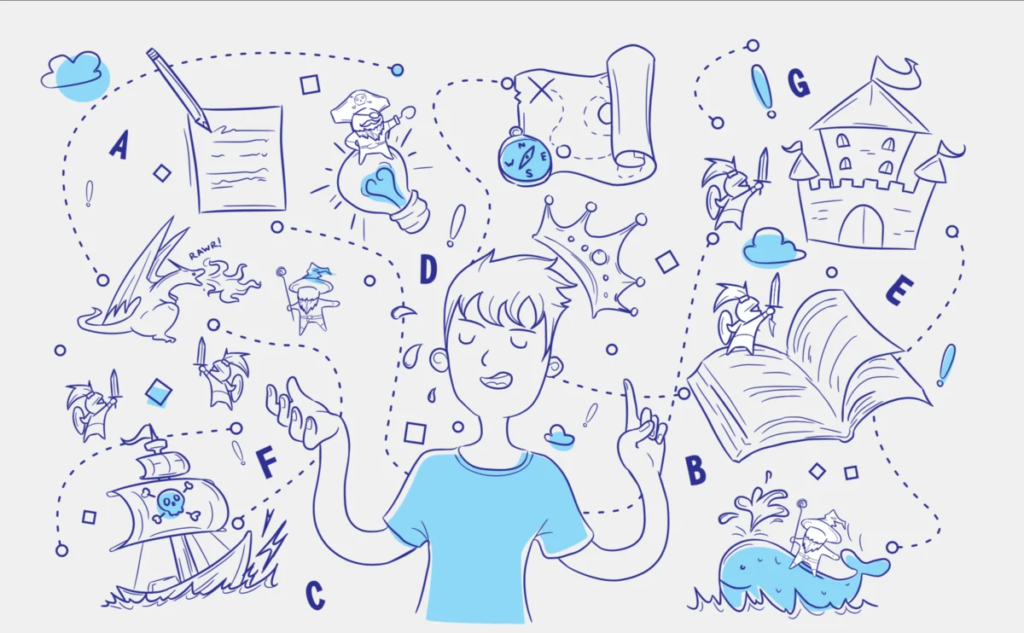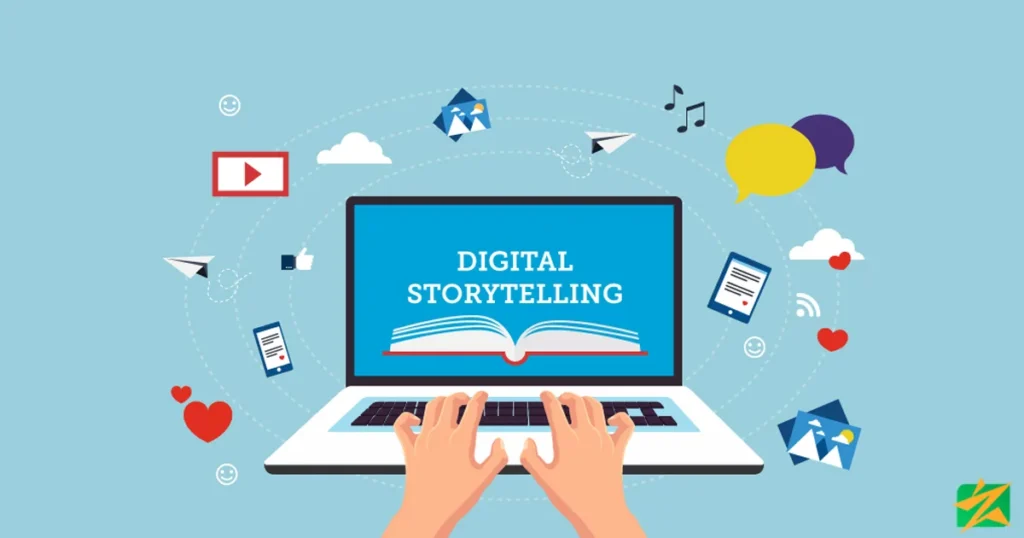Storytelling is an age-old tradition that has evolved over centuries, adapting to the changing landscapes of human communication. In the digital age, the art of storytelling has taken on a whole new dimension, where the fusion of creativity and technology has opened up exciting avenues for narrative exploration. As we delve into the intricate tapestry of storytelling in the digital realm, we uncover a world where words, images, sounds, and emotions converge to create immersive experiences that captivate audiences across the globe.

The Evolution of Storytelling
Throughout history, storytelling has been a fundamental means of sharing knowledge, culture, and values. From ancient oral traditions to written literature, stories have been a vessel for passing down human experiences. In the digital age, the narrative journey has embraced technology, allowing stories to be told and shared instantaneously, transcending geographical boundaries and reaching diverse audiences.
Importance of Storytelling in the Digital Age

In a world flooded with information, storytelling remains a potent tool for grabbing and retaining attention. In the digital age, where attention spans are fleeting and distractions are abundant, compelling narratives have become essential for conveying messages effectively. Storytelling breathes life into data, transforms concepts into relatable experiences, and creates emotional connections that resonate with audiences on a profound level.
Foundation of Compelling Stories
Understanding the Core Elements of a Story
At the heart of every great narrative lie key elements that form its foundation. Characters, setting, plot, and conflict intertwine to weave the intricate fabric of a story that engages and enthralls. Each element contributes to the overall narrative structure, offering a blueprint for storytellers to craft compelling tales that resonate with their audiences.
Characters: The Heart of Your Narrative
Characters serve as the driving force behind any story, acting as vessels through which readers or viewers immerse themselves in the narrative world. These personas, whether relatable, complex, or enigmatic, lend depth to the story’s emotional landscape, making it possible for audiences to forge connections and experience vicarious adventures.
Setting: Creating the Stage
The setting provides the backdrop against which the narrative unfolds. It is more than just a physical location; it’s an atmospheric canvas that sets the mood and tone of the story. A well-crafted setting transports audiences to new realms, allowing them to escape their realities and embark on journeys that ignite their imaginations.
Plot: Weaving the Thread of Engagement
The plot is the beating heart of storytelling, comprising the sequence of events that drive the narrative forward. It’s the path that characters navigate, filled with challenges, revelations, and moments of transformation. A carefully constructed plot keeps audiences hooked, eager to unravel the mysteries and uncertainties that lie ahead.
Conflict: Building Tension and Interest
Conflict infuses stories with tension, propelling characters through arcs of growth and change. Whether internal struggles or external challenges, conflict creates the stakes that invest audiences emotionally. It fuels anticipation, making readers or viewers eager to witness how characters overcome obstacles and evolve.
Crafting Digital Narratives

Embracing the Power of Multimedia
In the digital age, storytelling has transcended the confines of text. Multimedia elements, such as images, videos, and audio, enrich narratives by appealing to multiple senses. This fusion of media transforms storytelling into a dynamic and immersive experience that resonates deeply with modern audiences.
Incorporating Images and Visuals
Visual storytelling engages the eye and stimulates the imagination. Evocative images, illustrations, and graphics enhance the narrative’s emotional impact, painting vivid mental landscapes that linger long after the story is consumed.
Video Storytelling: Impactful and Engaging
Video has become a cornerstone of digital storytelling, offering a captivating blend of visual, auditory, and emotional stimuli. From short films to animated shorts, videos capture attention and convey complex narratives in ways that resonate with viewers on a profound level.
Utilizing Audio for Atmosphere
Soundscapes, music, and voice narration contribute to the auditory dimension of digital storytelling. The power of sound evokes emotions, sets the pace, and transports audiences to the heart of the narrative world, creating a holistic and multisensory experience.
Navigating Short Attention Spans
Hooking the Audience Early
In the digital landscape, first impressions matter more than ever. Capturing the audience’s attention within seconds is crucial to retaining their interest. A compelling opening, whether through a thought-provoking question, a shocking statement, or an intriguing scenario, entices readers or viewers to delve deeper.
Micro-Storytelling: Conveying Meaning in Minimal Words
Micro-stories, characterized by their brevity, are a response to the fast-paced nature of digital consumption. These concise narratives distill emotions, conflicts, and resolutions into a few impactful sentences, delivering a punch of meaning that resonates in the minds of audiences.
Structuring for Skim Readers
Online readers often skim through content, seeking key takeaways. Structuring narratives with informative headings, bullet points, and concise paragraphs caters to the needs of skim readers, ensuring that even a brief encounter with the story leaves an impression.
The Role of Emotion

Connecting on an Emotional Level
Emotions are the bridges that connect storytellers and audiences. Whether joy, sorrow, fear, or excitement, emotions foster empathy, allowing audiences to immerse themselves in the narrative and forge profound connections with characters and their experiences.
Eliciting Empathy in Digital Stories
Empathy is a cornerstone of effective storytelling, enabling audiences to step into the shoes of characters and experience their emotions firsthand. Skillful portrayal of characters’ internal struggles and triumphs triggers empathetic responses, fostering a deeper engagement with the narrative.
Leveraging Nostalgia and Sentimentality
Nostalgia and sentimentality tap into shared human experiences, creating a sense of familiarity that resonates with audiences. Nostalgic references and heartfelt moments transport audiences back to their own memories, evoking emotions that enrich the storytelling experience.
Personalization and Relatability

Creating Relatable Protagonists
Characters who mirror the diversity and complexities of real-life individuals become relatable protagonists. Readers or viewers see themselves in these characters, making their journeys more impactful and their growth more inspiring.
Tailoring Narratives to Diverse Audiences
Digital storytelling has a global reach, making cultural sensitivity and diversity crucial. Crafting narratives that resonate with diverse backgrounds and perspectives enriches the narrative experience, creating connections that transcend boundaries.
User-Generated Content: Harnessing Personal Stories
User-generated content empowers audiences to become co-creators of narratives. Sharing personal stories, experiences, and perspectives not only enriches the narrative but also fosters a sense of community and collaboration.
Interactive and Immersive Experiences
Gamification: Making the Audience Part of the Story
Gamification integrates storytelling with interactive elements, turning audiences into active participants. Through quizzes, polls, and interactive scenarios, audiences shape the narrative’s trajectory, fostering a sense of agency and engagement.
Augmented Reality (AR) and Virtual Reality (VR) in Storytelling
AR and VR technologies transport audiences into immersive worlds, blurring the lines between reality and fiction. These technologies enable experiential storytelling, allowing audiences to explore environments and interact with characters in unprecedented ways.
Interactive Fiction: Choose Your Path Adventures
Interactive fiction places readers at the crossroads of decision-making, enabling them to shape the narrative’s outcome. By offering choices and consequences, choose-your.
Interactive Fiction: Choose Your Path Adventures
own-path narratives empower audiences to be active co-authors of the story, enhancing engagement and personal investment.
Mastering Digital Platforms

Adapting Stories for Social Media
Social media platforms demand concise and impactful storytelling. Adapting narratives to platforms like Facebook, Instagram, and Twitter requires capturing the essence of the story in bite-sized formats that compel audiences to pause and engage.
Instagram Stories: Bite-sized Visual Narratives
Instagram Stories, with their ephemeral nature, demand creativity in conveying narratives within seconds. A mix of images, videos, and brief text snippets create a dynamic narrative canvas that disappears after 24 hours, fostering a sense of urgency and intimacy.
Twitter Threads: Crafting Narratives in 280 Characters
The concise nature of Twitter challenges storytellers to craft narratives within the confines of 280 characters per tweet. Crafting engaging and cohesive narrative threads, where each tweet is a piece of the larger story puzzle, keeps readers engaged as they anticipate the unfolding tale.
Blogging: Long-Form Storytelling in the Digital Realm
Long-form blogging offers an expansive canvas for in-depth storytelling. In a world where quick consumption is the norm, long-form content provides readers with the space to immerse themselves in detailed narratives, exploring intricate plots and character arcs.
Podcasting: Crafting Compelling Audio Stories
Podcasts blend the power of storytelling with the intimacy of the human voice. Through narration, interviews, and sound effects, podcasts transport listeners into imaginative worlds, creating a profound connection between storytellers and audiences.
Data-Driven Storytelling
Using Data to Enhance Your Narrative
Data-driven storytelling merges analytical insights with narrative creativity. Infusing statistics, research, and data visualizations enriches narratives with credibility and authority, while also offering readers a deeper understanding of the subject matter.
Infographics and Data Visualizations as Storytelling Tools
Infographics and data visualizations distill complex information into easily digestible visual narratives. Charts, graphs, and diagrams provide visual context, helping readers grasp intricate concepts and trends in a compelling and accessible manner.
Making Statistics and Numbers Engaging
Numbers, though often perceived as dry, can become dynamic storytelling elements. By contextualizing statistics within relatable scenarios and using them to emphasize key points, storytellers can turn data into captivating insights that resonate with audiences.
Storytelling Across Industries

Brand Storytelling: Forging Deeper Connections with Customers
In the business realm, brand storytelling builds connections that transcend products or services. By weaving narratives that reflect brand values, culture, and customer experiences, companies can engage customers on an emotional level, fostering loyalty and advocacy.
Storytelling in Education: Making Learning Engaging
Education embraces storytelling as a powerful tool for engaging students. Narratives bring history, science, and complex concepts to life, enabling students to connect with the material on a personal level and fostering a love for learning.
Healthcare and Storytelling: Humanizing Medical Narratives
In healthcare, storytelling humanizes medical experiences, making them relatable and accessible. Sharing patient stories, medical journeys, and triumphs over adversity not only educates the public but also fosters empathy and understanding.
Transmedia Storytelling
Extending Narratives Across Multiple Platforms
Transmedia storytelling transcends a single medium, spanning platforms like books, films, games, and social media. Each platform contributes a unique facet to the overarching narrative, creating a multi-dimensional experience that engages audiences on multiple levels.
The Role of Fan Participation in Transmedia
Transmedia narratives invite fan participation, encouraging audiences to explore and contribute to the story world. Fan art, fan fiction, and online discussions expand the narrative’s universe, fostering a sense of community and collective creativity.
Case Studies: Successful Transmedia Storytelling Campaigns
Examining successful transmedia storytelling campaigns, such as the Marvel Cinematic Universe, reveals how interconnected narratives across films, TV shows, and comics can captivate audiences and create a rich, expansive story universe.
Ethics and Authenticity
Navigating Truth and Fiction in Digital Stories
In the digital age, distinguishing between truth and fiction can be challenging. Storytellers must navigate ethical considerations, ensuring that their narratives inform and entertain without perpetuating misinformation or deceit.
Avoiding Misinformation and Sensationalism
With the ease of sharing information online, misinformation and sensationalism can spread quickly. Ethical storytelling demands fact-checking, responsible sourcing, and a commitment to accuracy to uphold the integrity of the narrative.
Building Trust Through Authentic Narratives
Authenticity builds trust with audiences. Sharing genuine stories, experiences, and challenges creates a connection that resonates deeply. Authentic narratives reveal vulnerability, inspiring readers or viewers to open up in return.
The Influence of Influencers
Collaborative Storytelling with Influencers
Influencers possess the power to amplify narratives. Collaborating with influencers allows brands and storytellers to leverage their reach and engagement, weaving narratives that align with the influencer’s persona and resonate with their audience.
The Power of Authentic Testimonials
Influencers’ authentic testimonials add credibility to narratives. Personal anecdotes and endorsements create a relatable connection between influencers and their followers, enhancing the narrative’s persuasive impact.
Balancing Brand Message with Influencer Voice
Successful influencer collaborations strike a balance between brand messaging and the influencer’s unique voice. The narrative should seamlessly integrate the brand’s story while aligning with the influencer’s style and values.
Measuring Storytelling Success
Defining Metrics for Digital Storytelling
Measuring the success of digital storytelling requires defining relevant metrics. Engagement rates, shares, comments, and audience sentiment offer insights into the narrative’s impact and reach.
Analyzing Engagement and Interaction
Engagement metrics provide a window into audience interaction with the narrative. Likes, shares, comments, and clicks indicate not only the narrative’s resonance but also the level of emotional investment it has garnered.
Case Studies: Measuring Impactful Digital Narratives
Examining case studies of successful digital narratives, such as viral marketing campaigns or compelling brand stories, showcases how metrics can quantify the narrative’s effectiveness and influence.
Adapting Storytelling to Emerging Technologies

Artificial Intelligence and Automated Storytelling
Artificial intelligence is transforming storytelling through automated content creation. AI-driven algorithms analyze data to generate narratives that cater to specific preferences, revolutionizing the way stories are crafted and consumed.
Blockchain and Storytelling: Ensuring Transparency and Ownership
Blockchain technology offers transparency and ownership in digital storytelling. NFTs (non-fungible tokens) allow creators to authenticate and monetize their content, creating a new paradigm where digital stories have tangible value.
The Future of Digital Storytelling: Predictions and Speculations
As technology continues to evolve, the future of digital storytelling holds exciting possibilities. Virtual reality, augmented reality, AI-generated narratives, and immersive experiences will redefine how audiences engage with stories.
Conclusion
In an ever-evolving digital landscape, the art of storytelling remains a timeless beacon. As technology and creativity converge, narratives have the power to transcend screens, capturing hearts and minds with their ability to entertain, educate, and inspire. Embracing the challenges and opportunities of the digital age while honoring the rich traditions of storytelling ensures that the narrative journey continues to flourish, forging connections that bridge the gap between storytellers and their eager audiences.
FAQ: The Art of Storytelling in the Digital Age
1. What exactly is storytelling in the digital age?
Storytelling in the digital age refers to the practice of crafting narratives using various digital mediums, such as text, images, videos, and audio, to engage and connect with modern audiences. It’s about adapting traditional storytelling techniques to the digital realm to capture attention and evoke emotions.
2. Why is storytelling important in the digital age?
In the digital age, where information is abundant and attention spans are short, storytelling acts as a powerful tool to convey messages effectively. Stories resonate with people on an emotional level, making information more relatable, memorable, and engaging.
3. How do core elements like characters, setting, plot, and conflict contribute to a story’s impact?
These core elements are the building blocks of a narrative. Characters make the story relatable, setting creates the backdrop, plot weaves the journey, and conflict builds tension. Combined, they create a cohesive and engaging story that draws readers or viewers in.
4. Can you explain micro-storytelling?
Micro-storytelling involves conveying meaningful messages in a concise manner, often within a few sentences. It’s a response to short attention spans, where the essence of a story is captured in minimal words, creating impactful moments in a short space.
5. How can emotions enhance storytelling in the digital age?
Emotions connect audiences to narratives on a deeper level. By evoking empathy, utilizing nostalgia, and creating relatable characters, storytelling taps into the emotional core of readers or viewers, making the experience more memorable and impactful.
6. What is transmedia storytelling?
Transmedia storytelling involves telling a story across multiple platforms, such as books, films, games, and social media. Each platform contributes to a larger narrative, creating an immersive and interconnected experience for audiences.
7. How does user-generated content contribute to storytelling?
User-generated content, like personal stories and experiences, allows audiences to become co-creators of narratives. Sharing their own perspectives enriches the story world and fosters a sense of community and collaboration.
8. How can I measure the success of my digital storytelling efforts?
Metrics like engagement rates, shares, comments, and audience sentiment can help measure the impact of digital storytelling. Analyzing these metrics provides insights into how effectively your narrative is resonating with your audience.
9. What role do influencers play in digital storytelling?
Influencers can amplify storytelling efforts by collaborating on content that aligns with their voice and values. Their testimonials and endorsements create authenticity, engaging their followers and expanding the reach of the narrative.
10. What does the future hold for digital storytelling?
The future of digital storytelling is poised to incorporate emerging technologies like AI, virtual reality, and blockchain. These innovations will reshape how narratives are created, consumed, and valued, offering new and exciting possibilities for storytellers and audiences alike.
Disclaimer:
The information provided in this article, “The Art of Storytelling in the Digital Age,” is intended for informational purposes only. The content is based on the author’s research and understanding as of the knowledge cutoff date in September 2021. The field of digital storytelling is continually evolving, and new developments may have occurred since that time. Readers are encouraged to conduct their own research and consult relevant experts or sources for the most up-to-date information and guidance. The author and publisher of this article are not responsible for any errors, omissions, or inaccuracies that may arise, nor for any actions taken based on the information presented in this article.
Read more HERE
Checkout our content HERE



Uma resposta